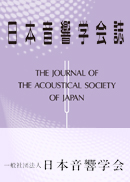All issues

Volume 18 (1962)
- Issue 6 Pages 301-
- Issue 5 Pages 269-
- Issue 4 Pages 187-
- Issue 3 Pages 109-
- Issue 2 Pages 45-
- Issue 1 Pages 1-
Volume 18, Issue 2
Displaying 1-5 of 5 articles from this issue
- |<
- <
- 1
- >
- >|
-
Kenji Aoyagi, Sadao MaekawaArticle type: Article
1962Volume 18Issue 2 Pages 45-53
Published: March 30, 1962
Released on J-STAGE: June 02, 2017
JOURNAL FREE ACCESSAn equipment for improving the signal to noise ratio of a sonar has been designed based on the delayed feedback theory. Because the delayed feedback circuit for the sonar needs the delay element with greater delay time in relation with the velocity of sound, the authors used the magnetic recorder as the delay element and applied the frequency modulation method to get rid of the wave from distortion. To make the delay time equal to the repetition period of the sonar pulse, the magnetic recorder utilizes two tracks, one of which carries the signal to be delayed and the other carries a synchronization pulse. Since the period of the synchronization pulse is equal to delay time of the signal, this pulse is fed to the sonar and synchronizes the generation period of the transmitting pulse. The results of the experiment are as follows: Using rectangular pulse as the echo, the degree of the signal to noise ratio improvement coincided fairly well with 1/1-α which was derived by the theory. On the other hand using the real sonar echo pulse, the photograph showed that this system enhanced the echo signal in the existing noise. Therefore, these results show that this system is effective for the increase of the sonar detecting performance.View full abstractDownload PDF (888K) -
Chosuke SugiArticle type: Article
1962Volume 18Issue 2 Pages 54-64
Published: March 30, 1962
Released on J-STAGE: June 02, 2017
JOURNAL FREE ACCESSIn some sort of ultrasonic equipment, resonant solid-horn is used as amplitude transformer. And, for this purpose, horn of exponential or conical type is used most commomly. Recently, L. G. Merkulov of USSR has investigated on catenodial solid-horn, and discovered that, in no load condition, this type horn gives greater transformation ratio than those of exponential and conical types. But, in most of the practical cases, the solid-horn has some sort of tip at its output end, and in such caces, the tip acts as a reactance load to the horn. Nevertheless, the character and optimum design method of catenoidal horn with reactance load has not been investigated yet. This paper deals with such problems and provides with a method of practical design, and for this purpose many useful design charts are presented. The mesured values on resonant frequency and transformation ratio of sevral examples, designed by the method described here, gave good agreements with the calculated values.View full abstractDownload PDF (873K) -
Masami Ishida, Norisatsu SanoArticle type: Article
1962Volume 18Issue 2 Pages 65-75
Published: March 30, 1962
Released on J-STAGE: June 02, 2017
JOURNAL FREE ACCESSApproximate equations denoting the treatment of the reflection of ultrasound from such small objects as plankton, air bubbles, mud grains etc in the sea are described with reference to the already published papers, and target strength or reflection losses of the above objects are calculated and graphed according to the equations. Measurements of reflection loss of the group of plankton (calanus plumchrus, 2〜3mm in length), air bubbles (1〜3mm in diameter) at 50kc and 200kc ultrasound are carried out in the experimental water tank and the measured values are compared with those calculated. A few experiments in the sea given too. Main results obtained are as follows: (1)Target strength T_s or reflection loss β_1 of the small spherical object is expressd approximately in the following form. β_1=20log_<10>[a/(2*10^2)*2ka^2|(1-gh^2)/(3gh^2)+(1-g)/(1+2g)|]^<-1> where, a:radius of sphere k:2π/(λ) λ:wave length of ultrasound in the surrounding medium g:(ρ')/ρ relative density h:(c')/c relative sound velocity (2)Experiments show that the reflection loss of the group of plankton (calanus plumchrus, 2〜3mm in length) at 50kc ultrasound decreases in nearly inverse proportion to √<N> (N is the total number of plankton) up to the average distribution density of plankton about (0. 3)/(cm^3). (3)Experiments show that the reflection loss of the group of air bubbles (about 2mm in diameter) at 50kc ultrasound is smaller than that at 200kc ultrasound since it is expected that such air bubbles acting as massive reactance elements in these frequency range vibrate less strongly as the frequency increases. Measured values of these reflection losses are about 5〜10dB smaller than that of the calculated ones.View full abstractDownload PDF (1888K) -
[in Japanese]Article type: Article
1962Volume 18Issue 2 Pages 76-81
Published: March 30, 1962
Released on J-STAGE: June 02, 2017
JOURNAL FREE ACCESSDownload PDF (821K) -
[in Japanese]Article type: Article
1962Volume 18Issue 2 Pages 82-90
Published: March 30, 1962
Released on J-STAGE: June 02, 2017
JOURNAL FREE ACCESSDownload PDF (790K)
- |<
- <
- 1
- >
- >|